Characterization and Evaluation of Thaw-Slumping Using GPR Attributes in the Qinghai–Tibet Plateau
Abstract
Simple Summary
Abstract
1. Introduction
2. Materials and Methods
2.1. Study Area
2.2. Overview of Thaw-Slumping Hazards
2.3. Test Site and Data Acquisition
2.4. Data Processing
2.5. Methods
2.5.1. Simulation of Geometric Feature and Noise Reflection Characteristics
2.5.2. Simulation of Amplitude Characteristics of Water Content Change
2.5.3. Calculation Method of Relative Water Content
3. Results
3.1. Stratification of Thaw-Slumping
3.2. Relative Water Content Analysis
4. Discussion
5. Conclusions
Supplementary Materials
Author Contributions
Funding
Institutional Review Board Statement
Informed Consent Statement
Data Availability Statement
Acknowledgments
Conflicts of Interest
References
- Wang, Y.; Jin, H.; Li, G. Investigation of the freeze–thaw states of foundation soils in frozen soil areas along the China–Russia Crude Oil Pipeline (CRCOP) route using ground-penetrating radar (GPR). Cold Reg. Sci. Technol. 2016, 126, 10–21. [Google Scholar] [CrossRef]
- Niu, F.J.; Gao, Z.Y.; Lin, Z.J.; Fan, X.W. Vegetation influence on the soil hydrological regime in frozen soil regions of the Qinghai-Tibet Plateau, China. Geoderma 2019, 354, 113892. [Google Scholar] [CrossRef]
- Shi, Y.; Niu, F.; Yang, C.; Che, T.; Lin, Z.; Luo, J. Frozen soil presence/absence mapping of the qinghai-tibet plateau based on multi-source remote sensing data. Remote Sens. 2018, 10, 309. [Google Scholar] [CrossRef]
- Niu, F.J.; Zhang, J.M.; Zhang, Z. Engineering geological characteristics and evaluations of frozen soil in Beiluhe testing field of Qinghai-Tibetan railway. J. Gla. Geo. 2002, 24, 264–269. [Google Scholar]
- Cheng, G.D. Research on engineering geology of the roadbed in frozen soil regions of Qinghai-Xizang plateau. Quat. Res. 2003, 23, 134–141. [Google Scholar]
- Niu, F.J.; Lin, Z.J.; Lu, J.H. Characteristics of Roadbed Settlement in Embankment-bridge Transition Section along the Qinghai-Tibet Railway in Frozen soil Regions. Cold Reg. Sci. Technol. 2011, 65, 437–445. [Google Scholar] [CrossRef]
- Niu, F.J.; Cheng, G.D.; Ni, W.K. Engineering-related slope failure infrozen soil regions of the Qinghai-Tibet Plateau. Cold Reg. Sci. Technol. 2005, 42, 215–225. [Google Scholar] [CrossRef]
- Yin, G.A. Characteristics of Frozen Soil in Beiluhe Basin of Qinghai-Tibet Plateau and Its Response to Climate Change. Ph.D. Thesis, Chinese Academy of Sciences, Lanzhou, China, 2017. [Google Scholar]
- Jin, W.D. Research on Slope Stability in Frozen Soil Regions of Qinghai-Tibet Plateau. Ph.D. Thesis, Changan University, Xi’an, China, 2004. [Google Scholar]
- Lantz, T.; Kokelj, S.V.; Gregel, S.E. Relative impacts of disturbance and temperature: Persistent changes in microenvironment and vegetation in retrogressive thaw slumps. Glob. Change Biol. 2009, 15, 1664–1675. [Google Scholar] [CrossRef]
- Song, L.; Yang, W.H.; Huang, J.H.; Li, H.P.; Zhang, X.J. GPR utilization in artificial freezing engineering. J. Geophys. Eng. 2013, 10, 034004. [Google Scholar] [CrossRef]
- Vladov, M.L.; Sudakova, M.S. Ground penetrating radar: From physical fundamentals to high-potential applications. In Teaching Guide; GEOS: Moscow, Russia, 2017; p. 240. (In Russian) [Google Scholar]
- Brown, J.; Hinkel, K.; Nelson, F. The circumpolar active layer monitoring (CALM) program: Research designs and initial results. Polar Geogr. 2000, 24, 166–258. [Google Scholar] [CrossRef]
- Hinkel, K.M.; Doolittle, J.A.; Bockheim, J.G.; Nelson, F.E.; Paetzold, R.; Kimble, J.M.; Travis, R. Detection of subsurface frozen soil features with ground penetrating radar, Barrow, Alaska. Permafr. Periglac. Process. 2001, 12, 179–190. [Google Scholar] [CrossRef]
- Schwamborn, G.; Wagner, D.; Hubberten, H.-W. The use of GPR to detect active layer in young periglacial terrain of Livingston. Island, Maritime Antarctica. Near Surf. Geophys. 2008, 6, 327–332. [Google Scholar] [CrossRef]
- Sudakova, M.; Sadurtdinov, M.; Skvortsov, A.; Tsarev, A.; Malkova, G.; Molokitina, N.; Romanovsky, V. Using ground penetrating radar for frozen soil monitoring from 2015–2017 at calm sites in the Pechora River delta. Remote Sens. 2021, 13, 3271. [Google Scholar] [CrossRef]
- Campbell, S.; Affleck, R.T.; Sinclair, S. Ground penetrating radar studies of frozen soil, periglacial, and near-surface geology at McMurdo Station, Antarctica. Cold Reg. Sci. Technol. 2017, 148, 38–49. [Google Scholar] [CrossRef]
- Luo, J. Study on Instability and Susceptibility Evaluation of Frozen Soil Slope in Qinghai-Tibet Engineering Corrido. Ph.D. Thesis, Chinese Academy of Sciences, Lanzhou, China, 2015. [Google Scholar]
- Robert, C. Time domain reflectometry method and its application for measuring moisture content in Po20. Measurement 2009, 42, 329–336. [Google Scholar]
- Weiler, K.W.; Teenhuis, T.S.; Kung, K.S. Comparison of ground penetrating radar and time domain reflectometry as soil water sensors. Soil Sci. Soc. Am. J. 1998, 62, 1237–1239. [Google Scholar] [CrossRef]
- Grote, K.H.; Ubbard, S.; Rubin, Y. Field-scale estimation of volumetric water content using ground penetrating radar ground wave techniques. Water Resour. Res. 2003, 39, 1–13. [Google Scholar] [CrossRef]
- Shen, Y.P.; Zuo, R.; Liu, J.K. Characterization and evaluation of frozen soil thawing using GPR attributes in the Qinghai-Tibet Plateau. Cold Reg. Sci. Technol. 2018, 151, 302–313. [Google Scholar] [CrossRef]
- Wang, Q.; Shen, Y. Calculation and interpretation of ground penetrating radar for temperature and relative water content of seasonal frozen soil in Qinghai-Tibet Platea. Electronics 2019, 8, 731. [Google Scholar] [CrossRef]
- Zou, D.; Lin, Z.; Yu, S.; Chen, J.; Cheng, G. A new map of frozen soil distribution on the Tibetan plateau. Chn. Phar. Affs. 1997, 11, 1–28. [Google Scholar]
- Zhao, L. A new map of permafrost distribution on the Tibetan Plateau. Cryosphere 2017, 11, 2527–2542. [Google Scholar] [CrossRef]
- Wang, S.L. Thaw slumping of Fenghuoshan area along Qinghai-Tibet highway. J. Glaciol. Geocryol. 1990, 12, 63–70. [Google Scholar]
- Jin, D.W. Study on slope stability in permafrost region of Qinghai-Tibet Plateau. Ph.D. Thesis, Changan University, Xi’an, China, 2004. [Google Scholar]
- Fu, J.N.; De, W.J.; Wei, M.A. Stability Analysis Methods for Evaluating Landslide of Thaw-slumping in Permafrost Regions. J. Glaciol. Geocryol. 2004, 26, 171–174. [Google Scholar]
- Warren, C.; Giannopoulos, A.; Giannakis, I. GprMax: Open source software to simulate electromagnetic wave propagation for Ground Penetrating Radar. Comput. Phys. Commun. 2016, 209, 163–170. [Google Scholar] [CrossRef]
- Topp, G.C.; Davis, J.L.; Annan, A.P. Electromagnetic determination of soil water content: Measurements in coaxial transmission lines. Water Resour. Res. 1980, 16, 574–582. [Google Scholar] [CrossRef]
- Yee, K.S. Numerical solution of initial boundary value problems involving Maxwell’s equations in isotropic media. IEEE Trans. Antennas Propag. 1996, 14, 302–307. [Google Scholar]
- Giannakis, I.; Giannopoulos, A.; Warren, C.A. Realistic FDTD Numerical Modeling Framework of Ground Penetrating Radar for Landmine Detection. IEEE J. Sel. Top. Appl. Earth Obs. Remote Sens. 2016, 9, 37–51. [Google Scholar] [CrossRef]
- Levin, G.G.; Vishnyakov, G.N.; Ilyushin, Y.A. Synthesis of three-dimensional phase images of nanoobjects: Numerical simulation. Opt. Spectrosc. 2013, 115, 938–946. [Google Scholar] [CrossRef]
- Galagedara, L.W.; Parkin, G.W.; Redman, J.D. An analysis of the ground-penetrating radar direct ground wave method for soil water content measurement. Hydrol. Process. 2003, 17, 3615–3628. [Google Scholar] [CrossRef]
- Huisman, J.A.; Hubbard, S.S.; Redman, J.D.; Annan, A.P. Measuring soil water content with ground penetrating radar. Vadose Zone J. 2003, 2, 476–491. [Google Scholar] [CrossRef]
- Di, B.Y.; Kamarudin, M.N. Ground water estimation and water table detection with ground penetrating radar. J. Asian Earth Sci. 2011, 4, 193–202. [Google Scholar] [CrossRef]
- Seger, M.A.; Nashait, A.F. Detection of water-table by using ground penetration radar. Eng. Technol. J. 2011, 29, 554–566. [Google Scholar]
- Pyke, K.; Eyuboglu, S.; Daniels, J.J.; Vendl, M.A. controlled experiment to determine the water table response using ground penetrating radar. J. Environ. Eng. Geophys. 2008, 13, 335–342. [Google Scholar] [CrossRef]
- Ma, F.J.; Lei, S.G.; Yang, S. Study on the relationship between soil moisture content and GPR signal properties. J. Soil Sci. 2014, 45, 809–815. [Google Scholar] [CrossRef]
- Peng, Z.Y.; Peng, S.P.; Du, W.F. Detection of soil water content using ground penetrating radar average envelope amplitude method. Trans. Chin. Soc. Agric. Eng. 2015, 31, 158–164. [Google Scholar] [CrossRef]
- Fu, J. Research on shallow soil moisture detection method based on ground penetrating radar technology. Ph.D. Thesis, Anhui University of Technology, Hefei, China, 2022. [Google Scholar]
- Liu, J. Model experimental study on prediction of subgrade moisture content based on GPR attributes. J. Rai. Sci. Eng. 2018, 15, 2240–2245. [Google Scholar] [CrossRef]
- Zhao, W.K. Research on Ground Penetrating Radar Attribute Technology and Its Application in Archaeological Investigation. Ph.D. Thesis, Zhejiang University, Hangzhou, China, 2013. [Google Scholar]
- Schmalz, B.; Lennartz, B.; Wachsmuth, D. Analyses of soil water content variations and GPR attribute distributions. J. Hydrol. 2002, 267, 217–226. [Google Scholar] [CrossRef]
- Tronicke, J.; Böniger, U. GPR attribute analysis: There is more than amplitudes. First Brk. 2013, 31, 103–108. [Google Scholar] [CrossRef]
- Niu, J.; Liu, Y.; Jiang, W.; Li, X.; Kuang, G. Weighted average frequency algorithm for Hilbert–Huang spectrum and its application to micro-Doppler estimation. IET Radar Sonar Navig. 2012, 6, 595–602. [Google Scholar] [CrossRef]
- Gao, J.H.; Wang, Q.; Liu, N.H. Weighted average instantaneous frequency extraction via time-frequency analysis. In Proceedings of the 79th EAGE Conference and Exhibition, Paris, France, 12–15 June 2017. [Google Scholar] [CrossRef]
- Ogiesoba, O.C. Application of thin-bed indicator and sweetness attribute in the evaluation of sediment composition and depositional geometry in coast-perpendicular subbasins, South Texas Gulf Coast. Interpretation 2017, 5, 87–105. [Google Scholar] [CrossRef]
- Zheng, J.; Peng, G.; Sun, J.; Zhen, Z. Fusing amplitude and frequency attributes for hydrocarbon detection using 90° phase shift data. Geophys. Prospect. Pet. 2019, 58, 130–138. [Google Scholar]
- Hart, B.S. Channel detection in 3-D seismic data using sweetness. AAPG Bull. 2008, 92, 733–742. [Google Scholar] [CrossRef]
- Loughlin, P.J. Comments on the interpretation of instantaneous frequency. IEEE Signal Process. Lett. 1997, 4, 123–125. [Google Scholar] [CrossRef]

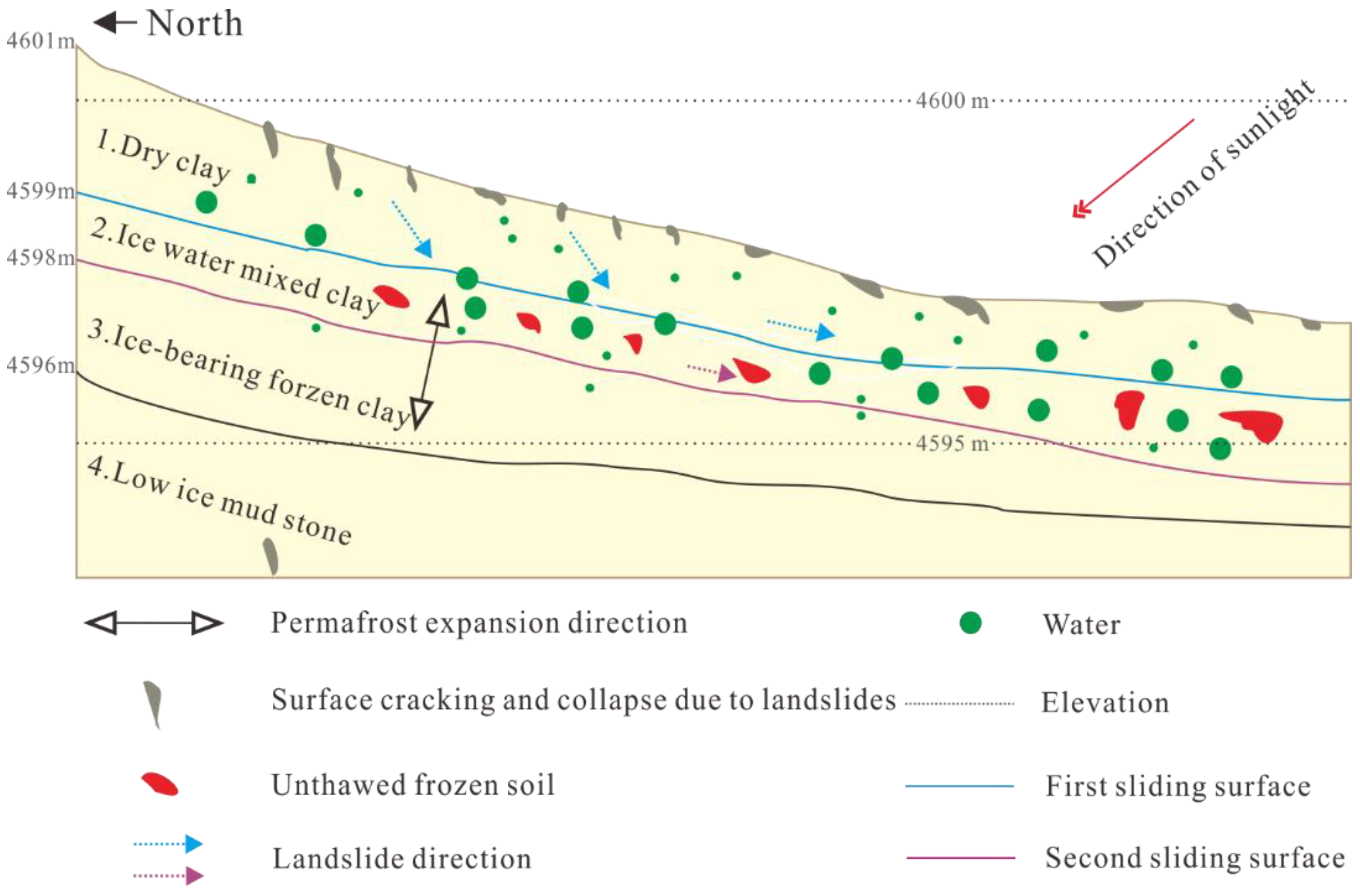
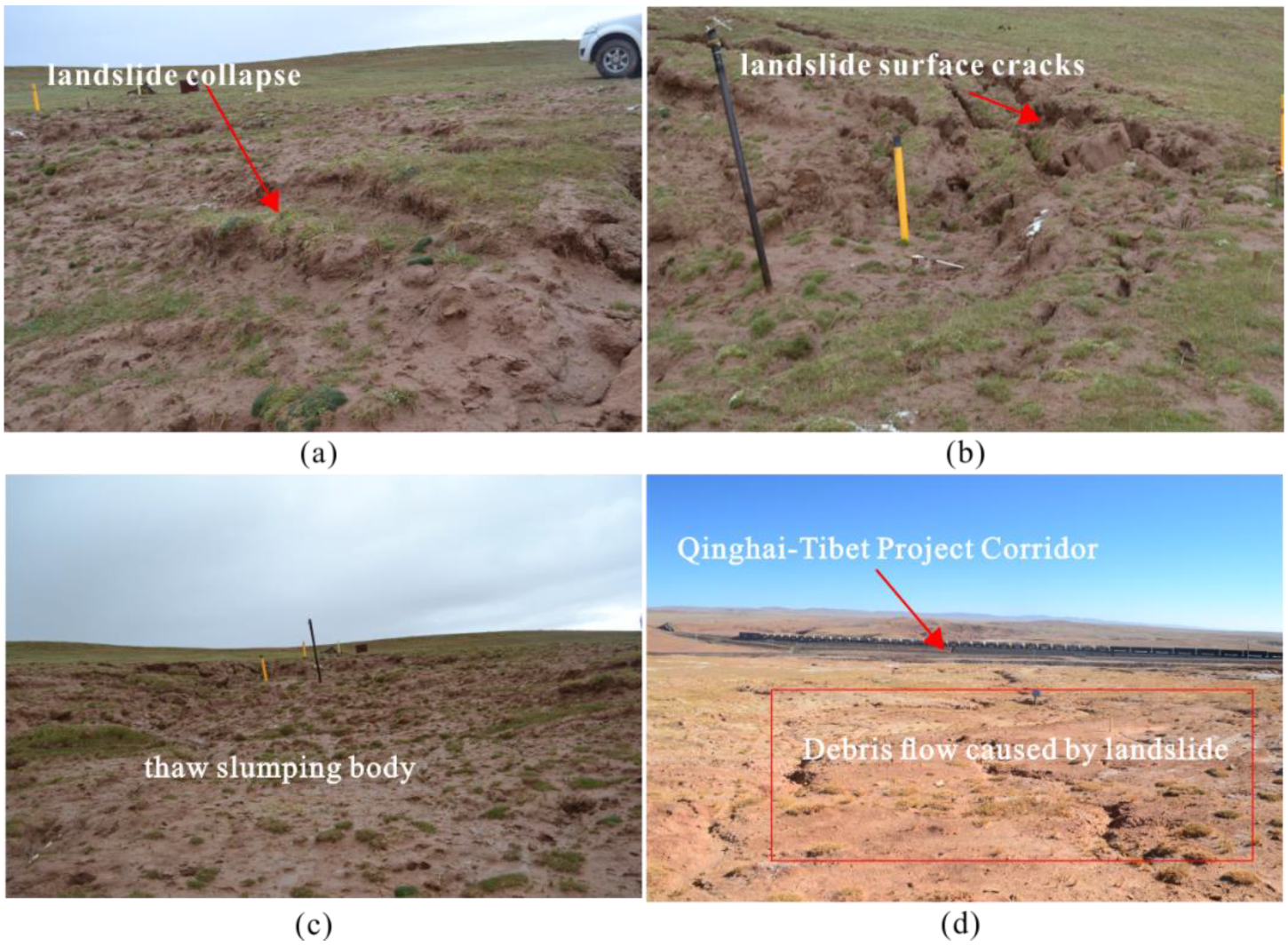
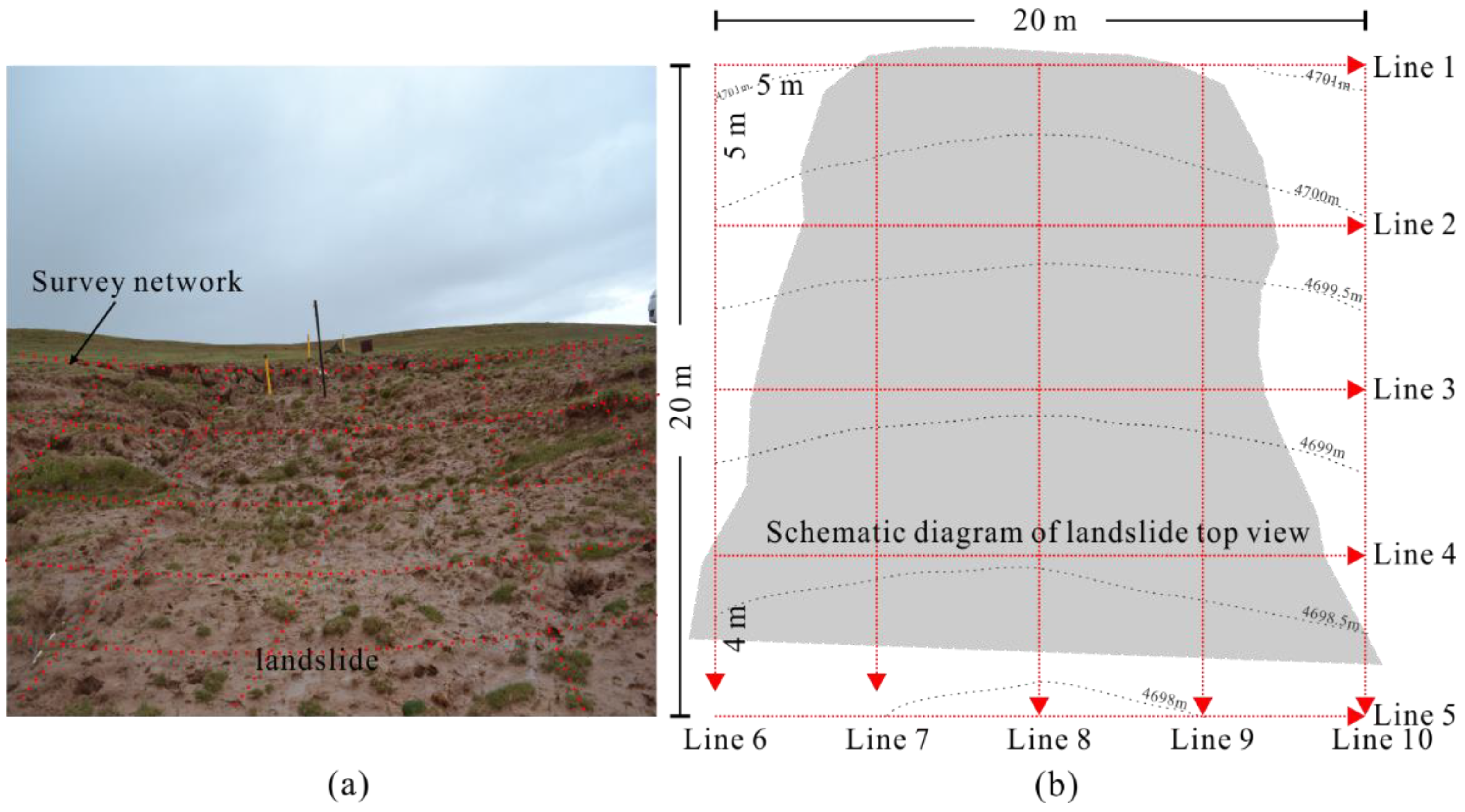
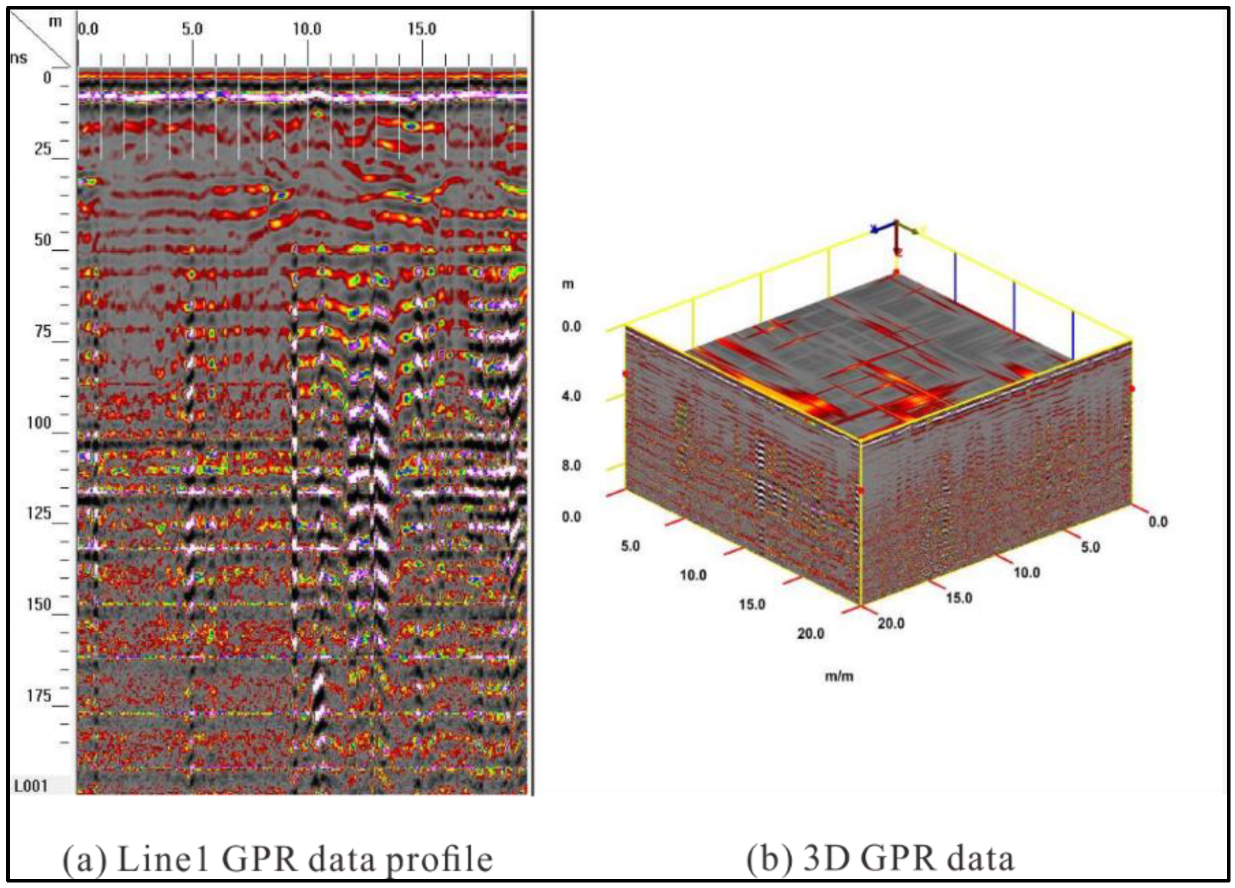

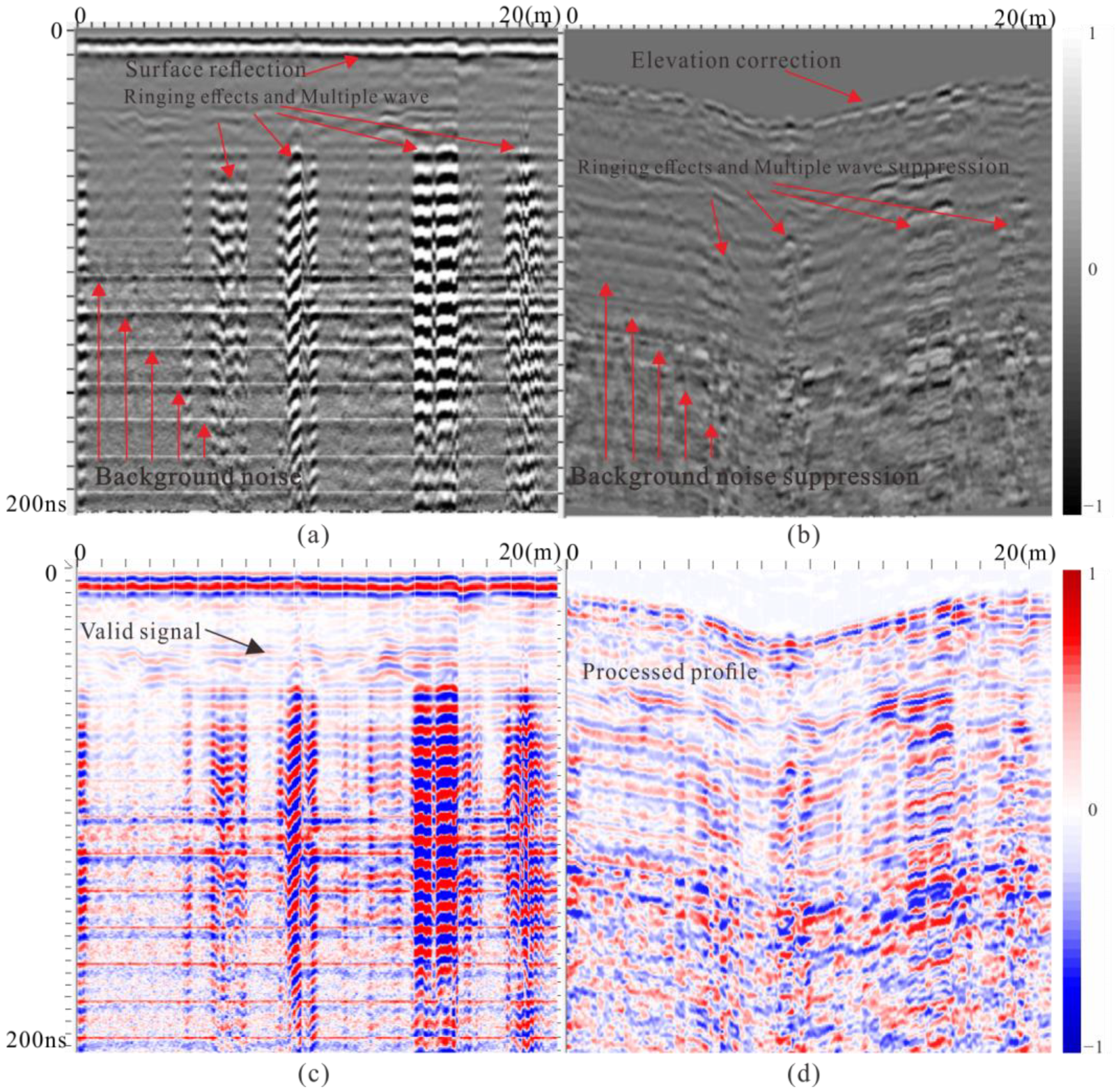


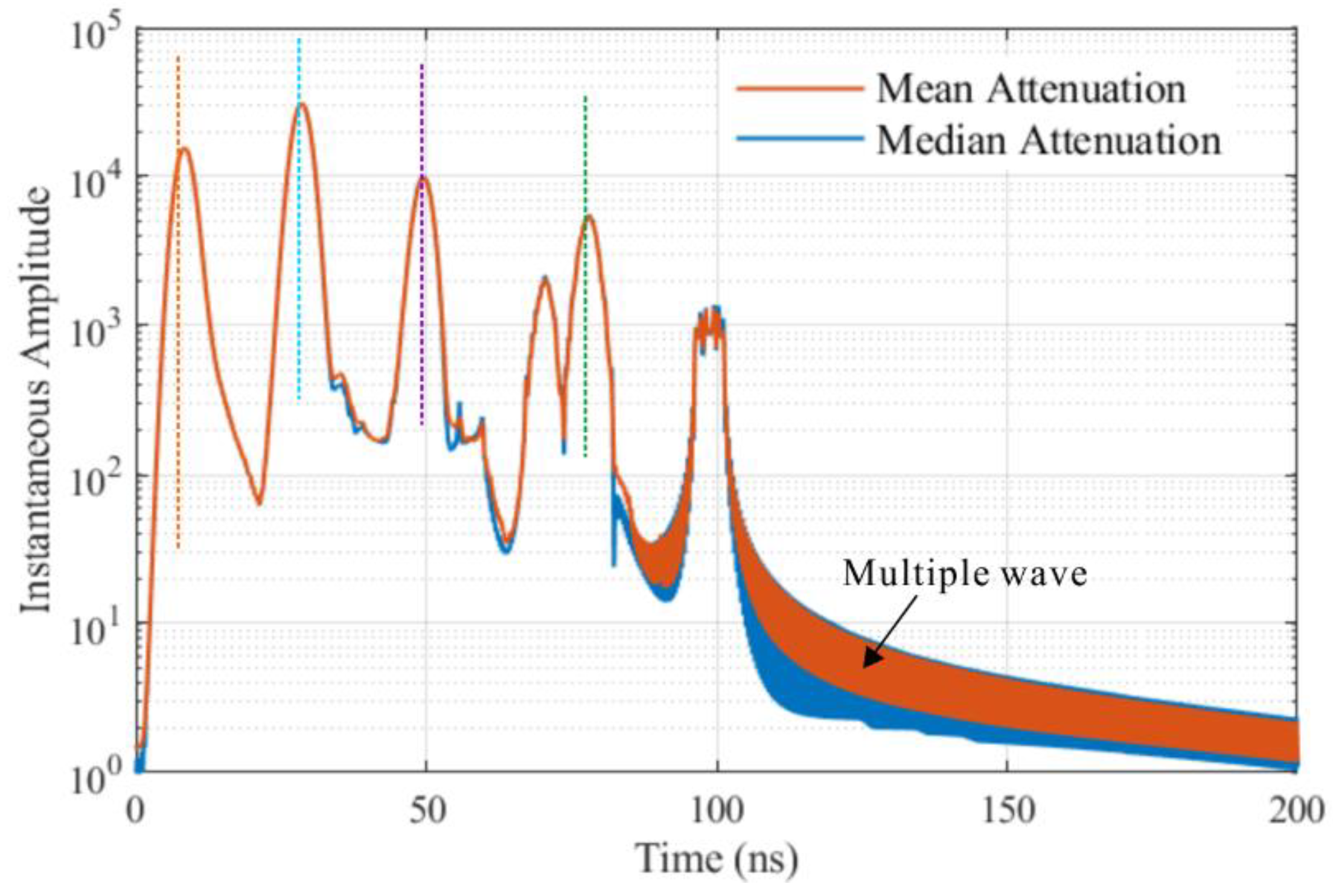
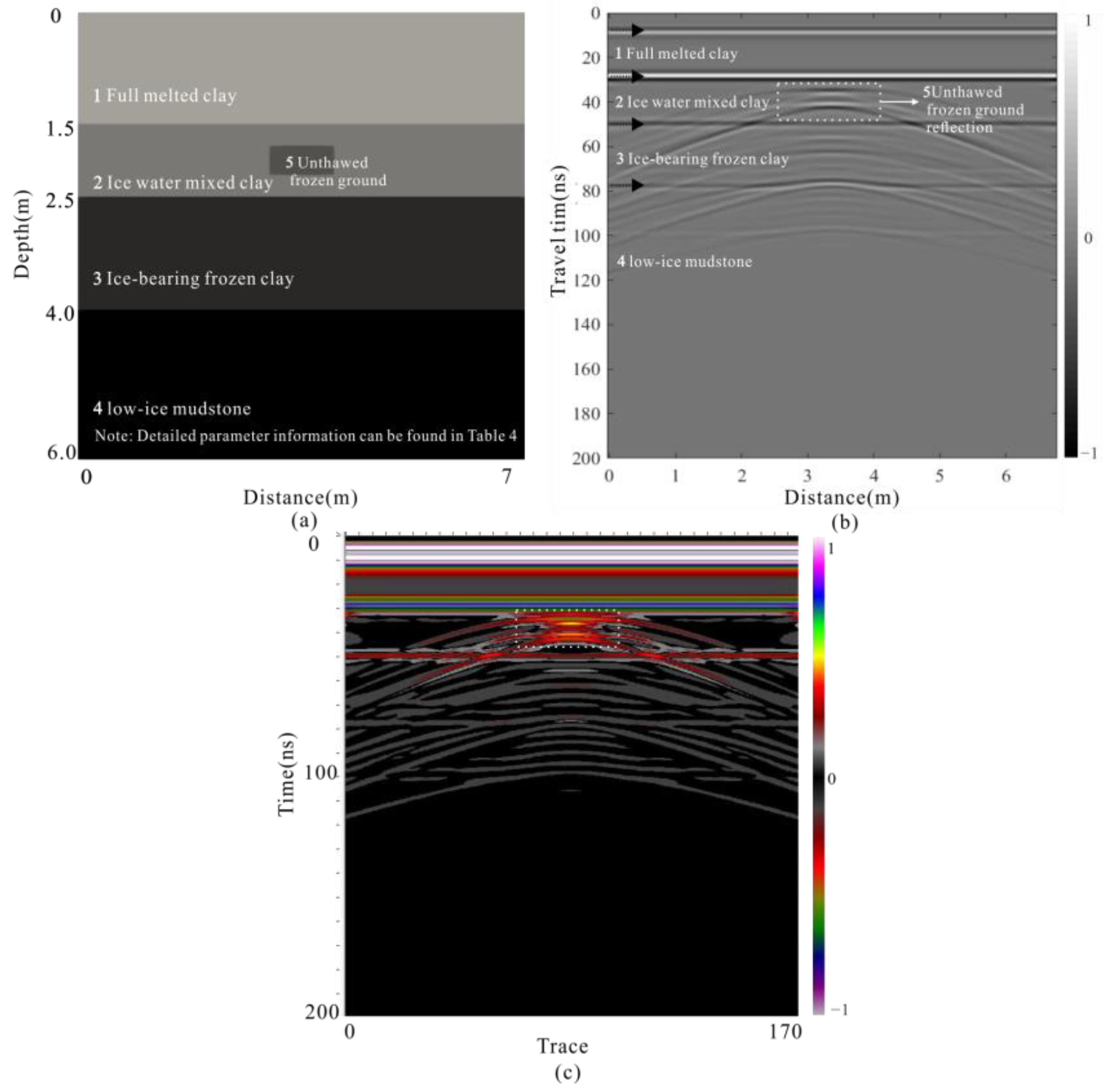
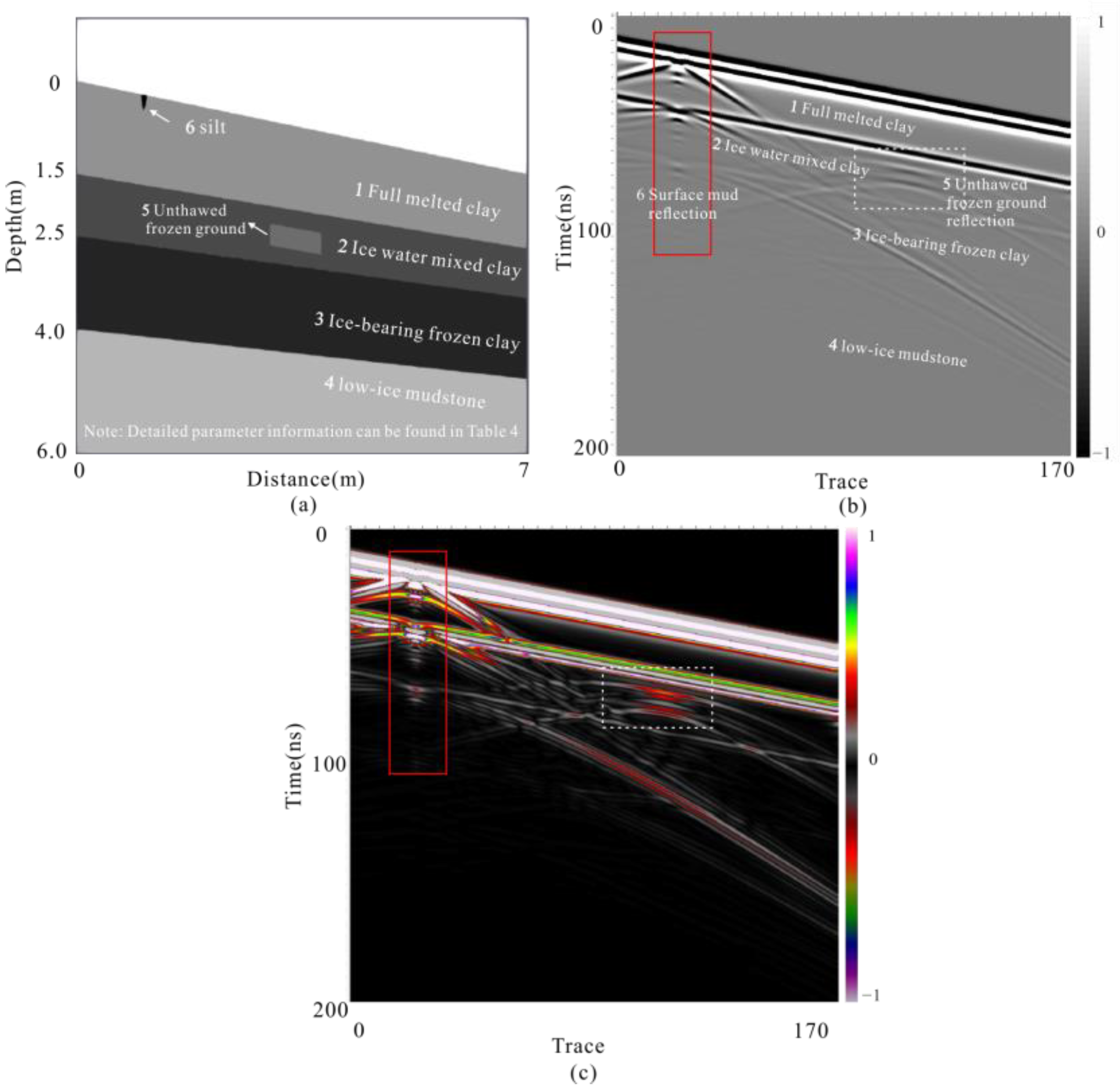
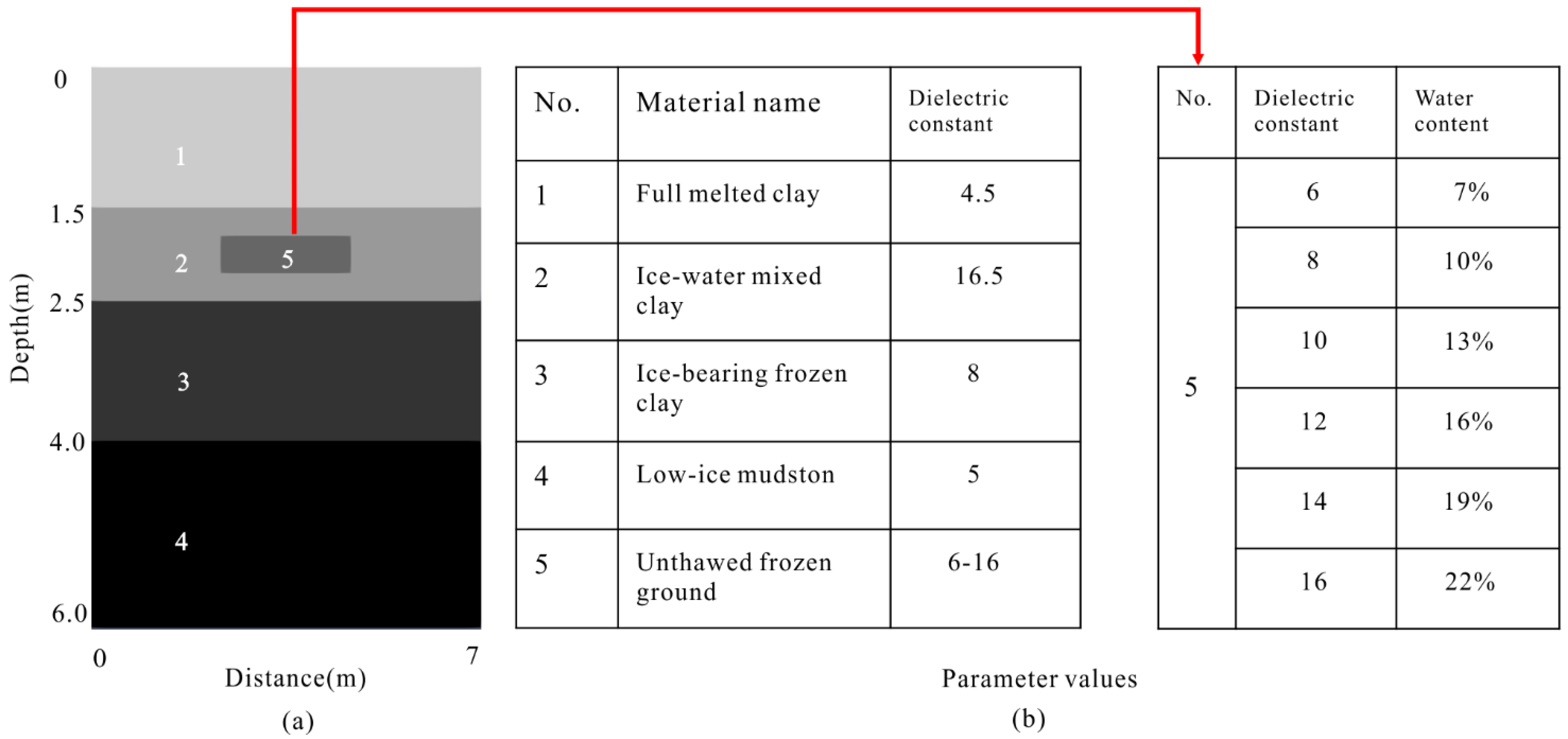
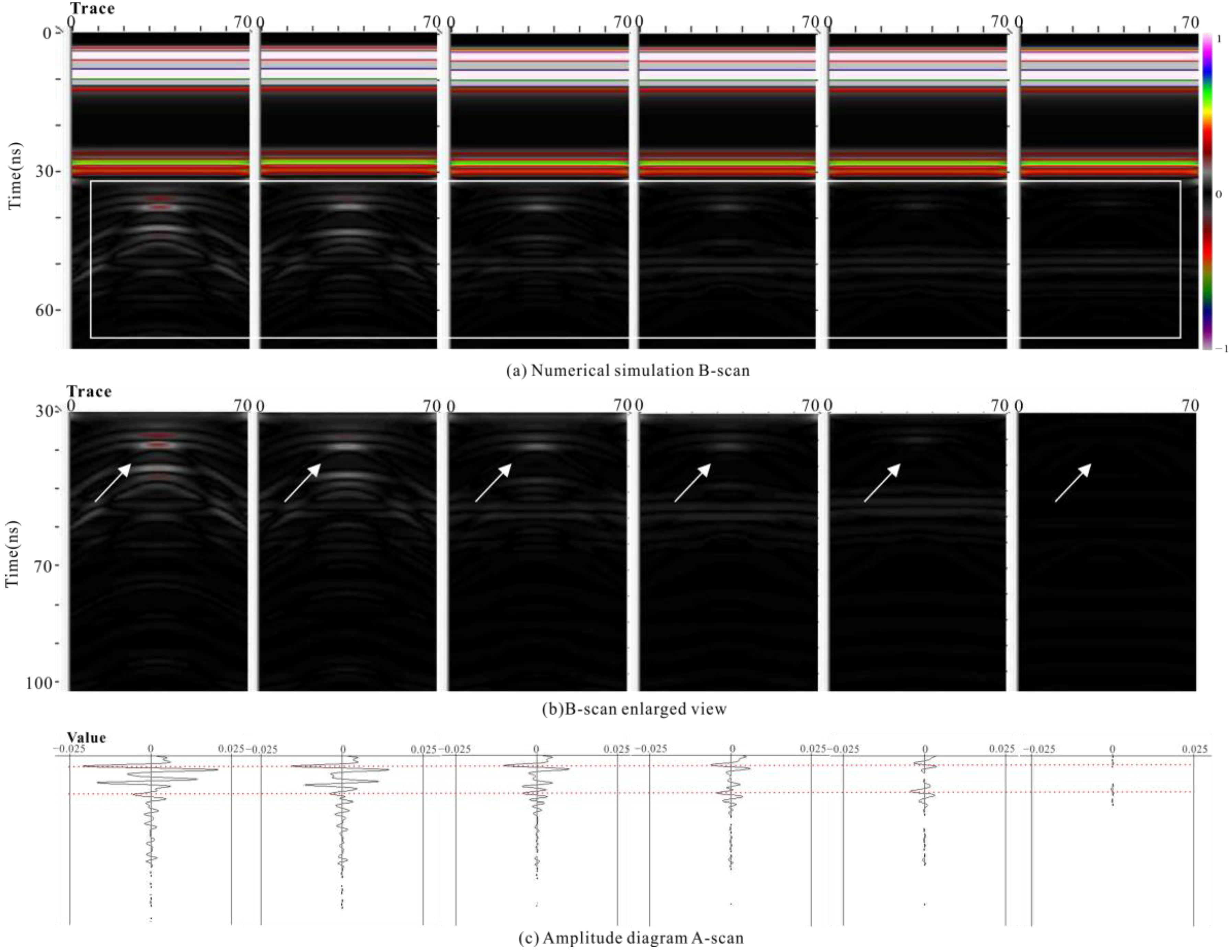
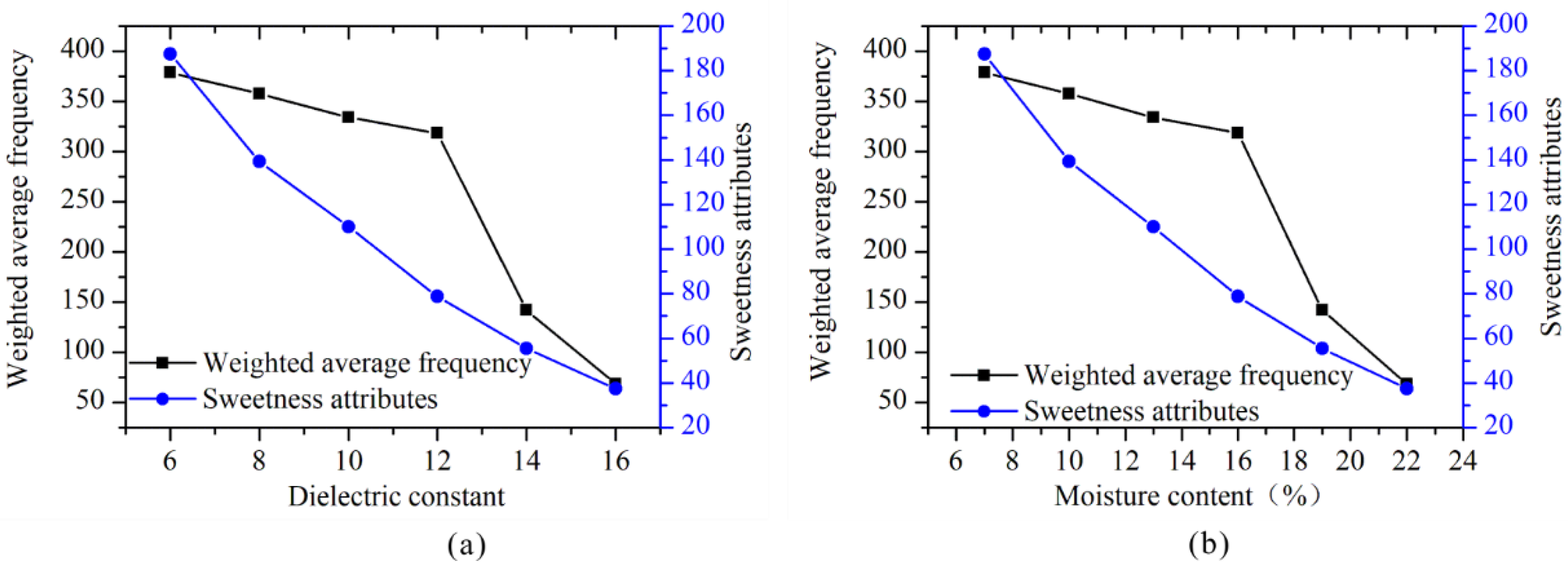
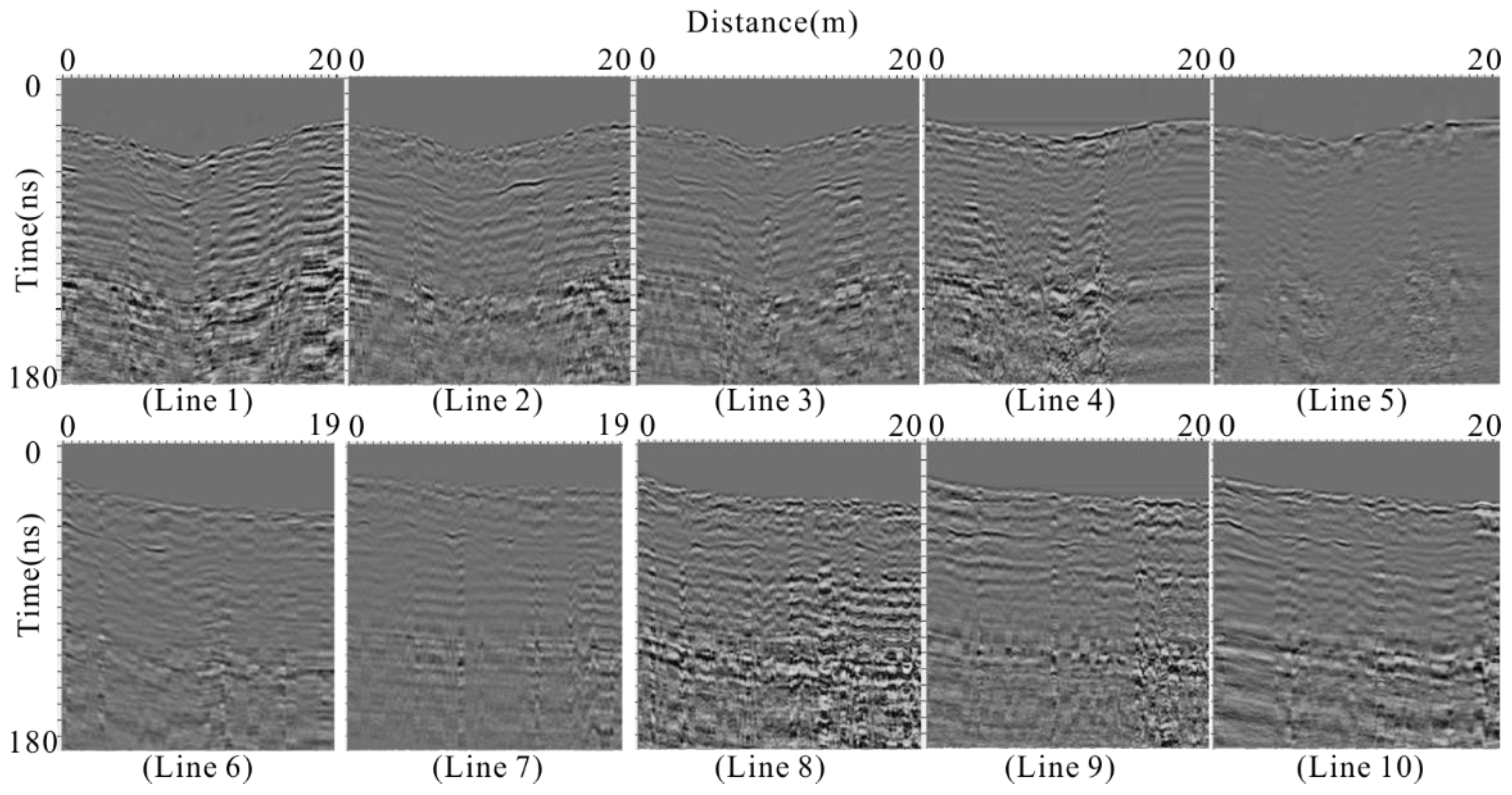

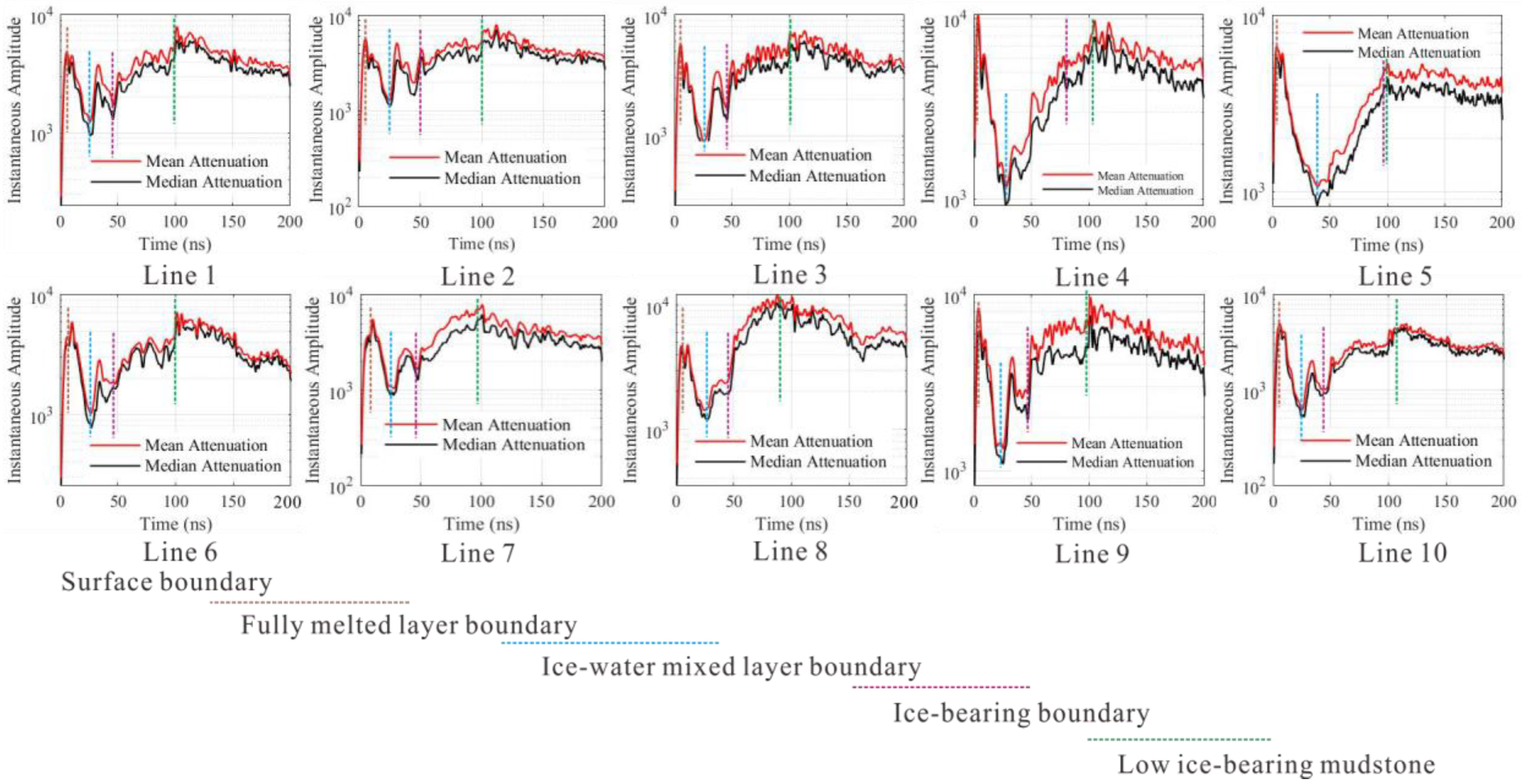

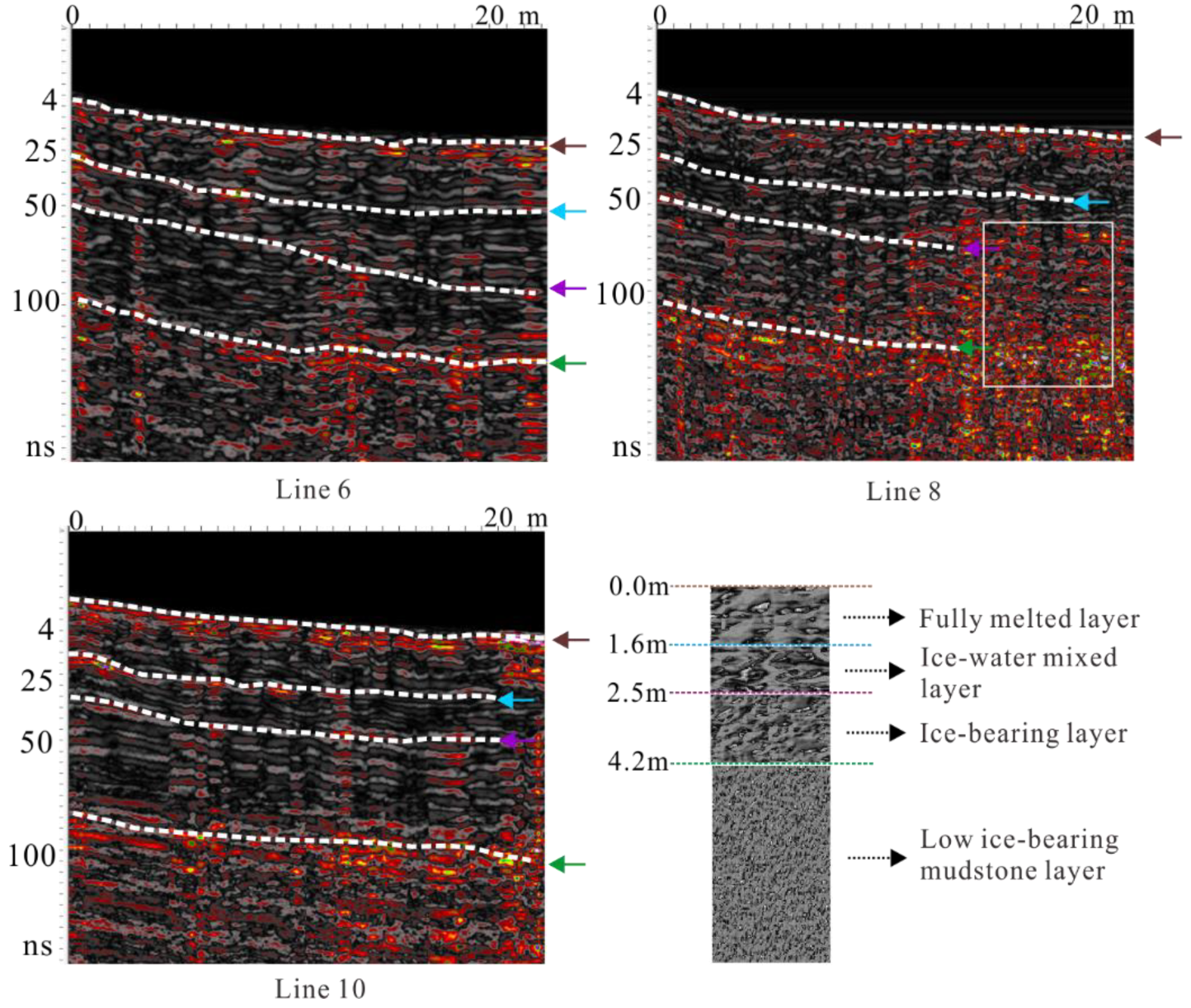
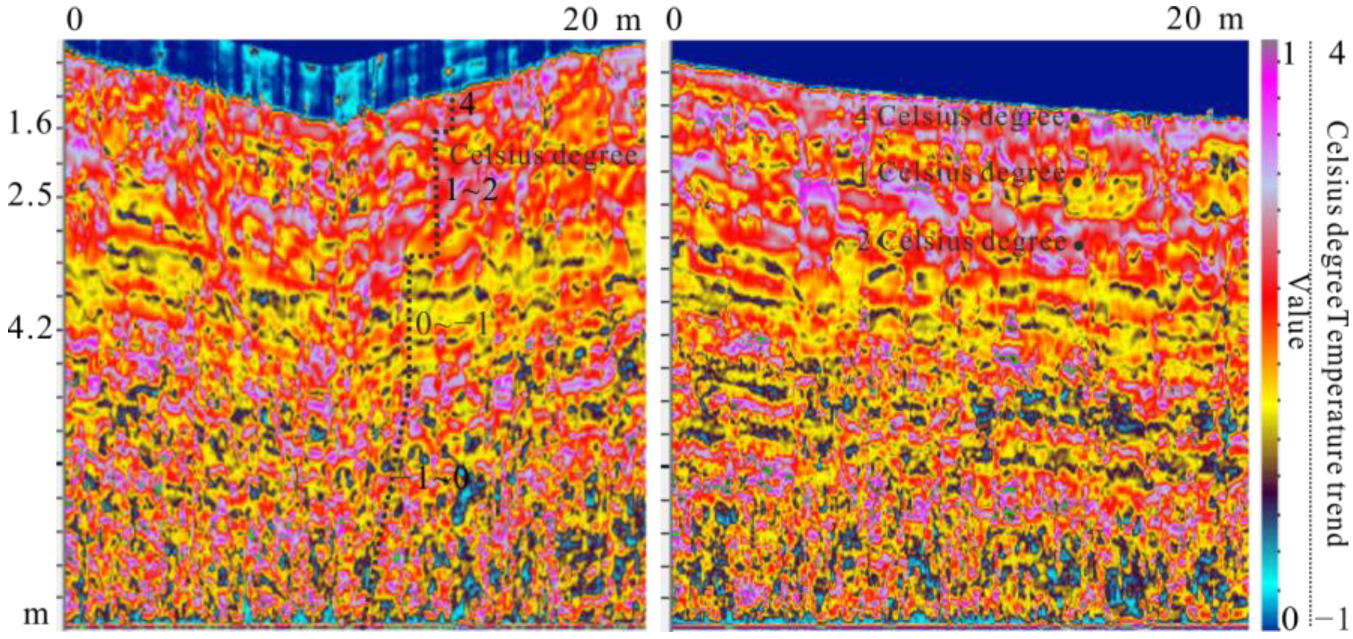
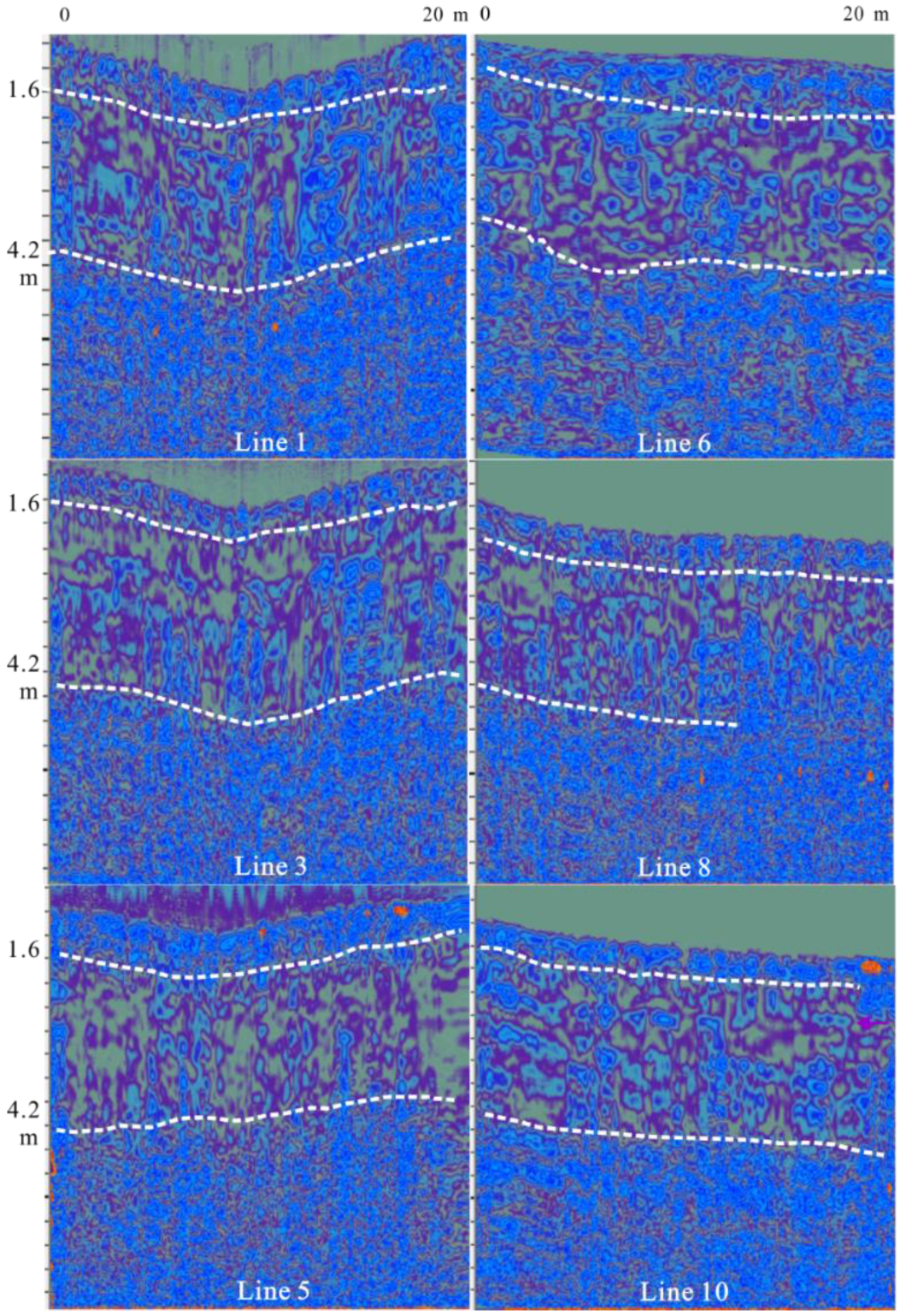
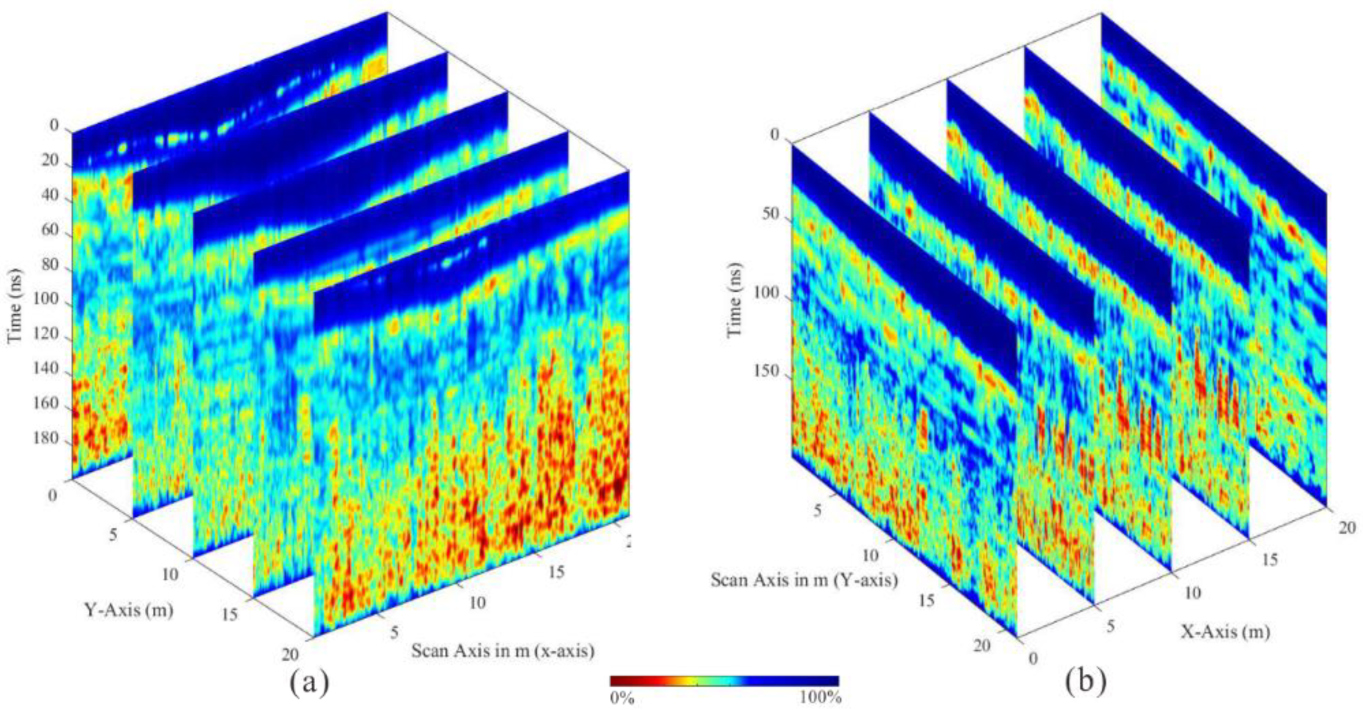
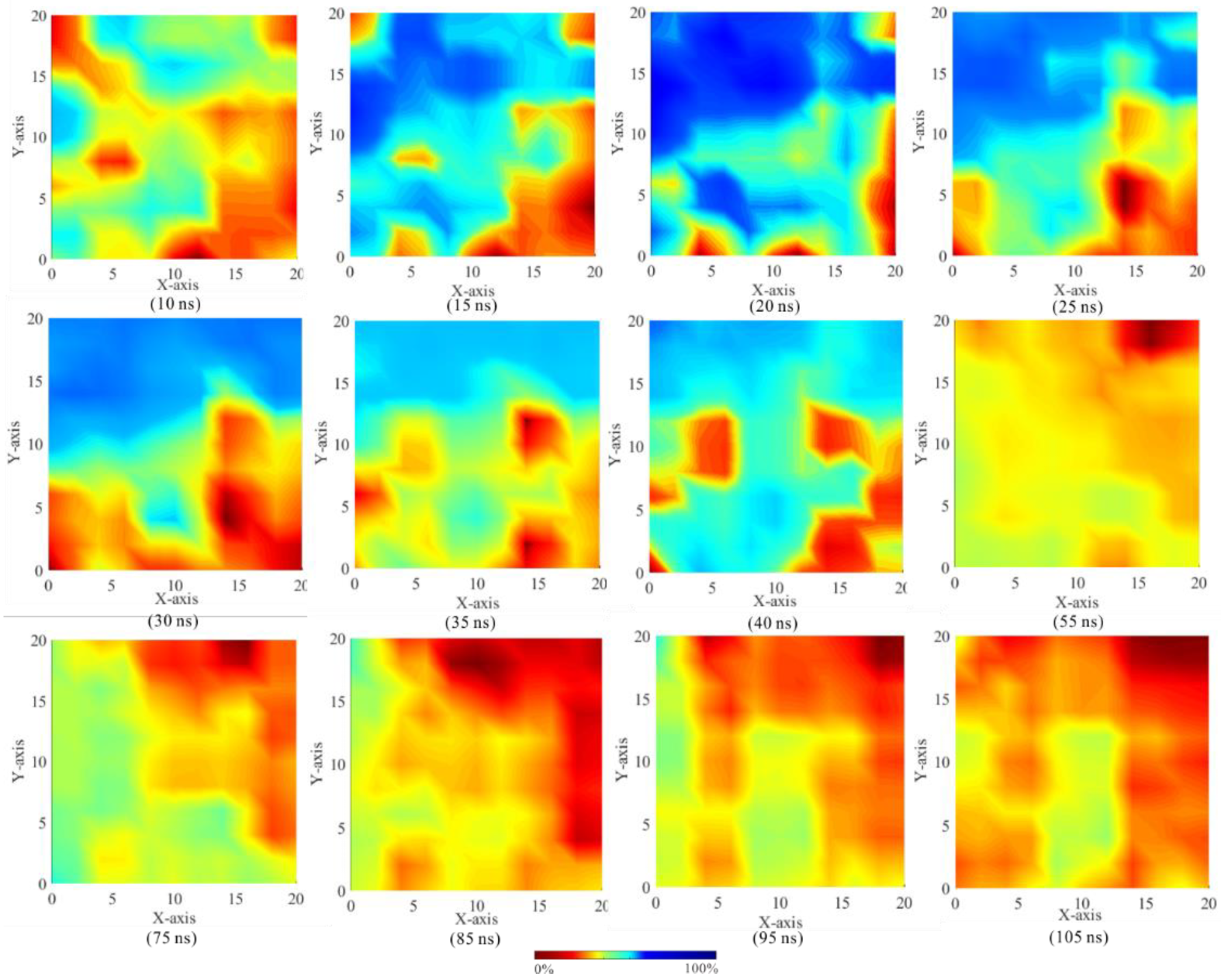
| Parameters | Values |
|---|---|
| Dimension | 3 |
| Line spacing | 5 m |
| Number of lines | 10 |
| Line length | 20 m |
| Parameters | Values |
|---|---|
| antenna center frequency | 200 MHz |
| scan/second | 153 |
| unit/mark | 1 m |
| sample/scan | 512 |
| Time window | 200 ns |
| Measurement mode | Survey wheel |
| Relative permittivity | 10 |
| No. | Data Processing Method | Basic Parameters | Values |
|---|---|---|---|
| 1 | Horizontal scaling | Stretching of scans | 3 |
| 2 | Data trace quality analysis | Delete | Bad and invalid trace data |
| 3 | Gain compensation | AGC | 3–6 |
| 4 | Remove background | Full pass | Automatic calculation |
| 5 | FIR filtering | Bandpass | 40 MHz~450 MHz |
| 6 | IIR filtering | Bandpass | 30 MHz~500 MHz |
| 7 | Elevation correction | Boxcar | Measurement data |
| 8 | Deconvolution | Operator length | 31 |
| Prediction lag | 5 | ||
| Pre-whitening % | 8 | ||
| Overall gain | 2 |
| Media Serial Number | Media Type | Relative Permittivity ɛ | Conductivity Σ (S/m) | Depth (m) |
|---|---|---|---|---|
| 1 | Full melted clay | 4.5 | 0.00027 | 0 |
| 2 | Ice-water mixed clay | 10 | 0.03 | 1.5 |
| 3 | Ice-bearing frozen clay | 8 | 0.001 | 2.5 |
| 4 | low-ice mudstone | 5 | 0.00015 | 4 |
| 5 | Unthawed frozen ground | 6 | 0.0003 | 2.4 |
| 6 | silt | 16 | 0.035 | 0 |
| Domain (m) | dx_dy_dz (m) | Waveform | Antenna Transmitting and Receiving Distance (m) | Number of Acquisition Channels and Acquisition Time | Antenna Center Frequency |
|---|---|---|---|---|---|
| 7 × 77 | 0.01 | Ricker wavelet | 0.04 | 170 trace and 200 ns | 200 MHz |
| Parameter | Numerical Value | |||||
|---|---|---|---|---|---|---|
| Maximum amplitude value | 0.02 | 0.014 | 0.009 | 0.0059 | 0.0024 | 0.00028 |
| Dielectric constant | 6 | 8 | 10 | 12 | 14 | 16 |
| Water content | 7% | 10% | 13% | 16% | 19% | 22% |
| No. | Radar Attribute | R | No. | Radar Attribute | R |
|---|---|---|---|---|---|
| 1 | waveform difference | 0.42 | 10 | relative impedance | 0.71 |
| 2 | instantaneous amplitude | 0.68 | 11 | average weighted frequency | 0.84 |
| 3 | instantaneous frequency | 0.52 | 12 | thin-bed indicator | 0.25 |
| 4 | instantaneous phase | 0.35 | 13 | sweetness | 0.82 |
| 5 | instantaneous bandwidth | 0.24 | 14 | phase rotation | 0.15 |
| 6 | instantaneous dominant frequency | 0.41 | 15 | response frequency | 0.22 |
| 7 | instantaneous Q | 0.48 | 16 | instantaneous acceleration | 0.10 |
| 8 | response phase | 0.28 | 17 | cosine of instantaneous phase | 0.18 |
| 9 | amplitude | 0.86 | 18 | apparent polarity | 0.21 |
Disclaimer/Publisher’s Note: The statements, opinions and data contained in all publications are solely those of the individual author(s) and contributor(s) and not of MDPI and/or the editor(s). MDPI and/or the editor(s) disclaim responsibility for any injury to people or property resulting from any ideas, methods, instructions or products referred to in the content. |
© 2023 by the authors. Licensee MDPI, Basel, Switzerland. This article is an open access article distributed under the terms and conditions of the Creative Commons Attribution (CC BY) license (https://creativecommons.org/licenses/by/4.0/).
Share and Cite
Wang, Q.; Liu, X.; Shen, Y.; Li, M. Characterization and Evaluation of Thaw-Slumping Using GPR Attributes in the Qinghai–Tibet Plateau. Remote Sens. 2023, 15, 2273. https://doi.org/10.3390/rs15092273
Wang Q, Liu X, Shen Y, Li M. Characterization and Evaluation of Thaw-Slumping Using GPR Attributes in the Qinghai–Tibet Plateau. Remote Sensing. 2023; 15(9):2273. https://doi.org/10.3390/rs15092273
Chicago/Turabian StyleWang, Qing, Xinyue Liu, Yupeng Shen, and Meng Li. 2023. "Characterization and Evaluation of Thaw-Slumping Using GPR Attributes in the Qinghai–Tibet Plateau" Remote Sensing 15, no. 9: 2273. https://doi.org/10.3390/rs15092273
APA StyleWang, Q., Liu, X., Shen, Y., & Li, M. (2023). Characterization and Evaluation of Thaw-Slumping Using GPR Attributes in the Qinghai–Tibet Plateau. Remote Sensing, 15(9), 2273. https://doi.org/10.3390/rs15092273






